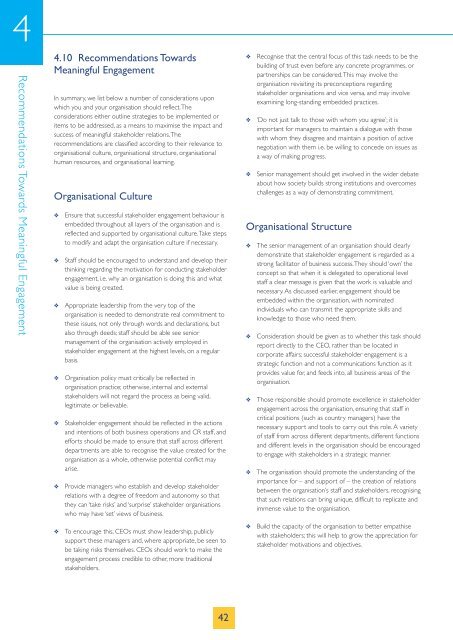Stakeholder Engagement - Cranfield School of Management ...
Stakeholder Engagement - Cranfield School of Management ...
Stakeholder Engagement - Cranfield School of Management ...
You also want an ePaper? Increase the reach of your titles
YUMPU automatically turns print PDFs into web optimized ePapers that Google loves.
4<br />
Recommendations Towards Meaningful <strong>Engagement</strong><br />
4.10 Recommendations Towards<br />
Meaningful <strong>Engagement</strong><br />
In summary, we list below a number <strong>of</strong> considerations upon<br />
which you and your organisation should reflect.The<br />
considerations either outline strategies to be implemented or<br />
items to be addressed, as a means to maximise the impact and<br />
success <strong>of</strong> meaningful stakeholder relations.The<br />
recommendations are classified according to their relevance to<br />
organisational culture, organisational structure, organisational<br />
human resources, and organisational learning.<br />
Organisational Culture<br />
❖ Ensure that successful stakeholder engagement behaviour is<br />
embedded throughout all layers <strong>of</strong> the organisation and is<br />
reflected and supported by organisational culture.Take steps<br />
to modify and adapt the organisation culture if necessary.<br />
❖ Staff should be encouraged to understand and develop their<br />
thinking regarding the motivation for conducting stakeholder<br />
engagement, i.e. why an organisation is doing this and what<br />
value is being created.<br />
❖ Appropriate leadership from the very top <strong>of</strong> the<br />
organisation is needed to demonstrate real commitment to<br />
these issues, not only through words and declarations, but<br />
also through deeds; staff should be able see senior<br />
management <strong>of</strong> the organisation actively employed in<br />
stakeholder engagement at the highest levels, on a regular<br />
basis.<br />
❖ Organisation policy must critically be reflected in<br />
organisation practice; otherwise, internal and external<br />
stakeholders will not regard the process as being valid,<br />
legitimate or believable.<br />
❖ <strong>Stakeholder</strong> engagement should be reflected in the actions<br />
and intentions <strong>of</strong> both business operations and CR staff, and<br />
efforts should be made to ensure that staff across different<br />
departments are able to recognise the value created for the<br />
organisation as a whole, otherwise potential conflict may<br />
arise.<br />
❖ Provide managers who establish and develop stakeholder<br />
relations with a degree <strong>of</strong> freedom and autonomy so that<br />
they can ‘take risks’ and ‘surprise’ stakeholder organisations<br />
who may have ‘set’ views <strong>of</strong> business.<br />
❖ To encourage this, CEOs must show leadership, publicly<br />
support these managers and, where appropriate, be seen to<br />
be taking risks themselves. CEOs should work to make the<br />
engagement process credible to other, more traditional<br />
stakeholders.<br />
42<br />
❖ Recognise that the central focus <strong>of</strong> this task needs to be the<br />
building <strong>of</strong> trust even before any concrete programmes, or<br />
partnerships can be considered.This may involve the<br />
organisation revisiting its preconceptions regarding<br />
stakeholder organisations and vice versa, and may involve<br />
examining long-standing embedded practices.<br />
❖ ‘Do not just talk to those with whom you agree’; it is<br />
important for managers to maintain a dialogue with those<br />
with whom they disagree and maintain a position <strong>of</strong> active<br />
negotiation with them i.e. be willing to concede on issues as<br />
a way <strong>of</strong> making progress.<br />
❖ Senior management should get involved in the wider debate<br />
about how society builds strong institutions and overcomes<br />
challenges as a way <strong>of</strong> demonstrating commitment.<br />
Organisational Structure<br />
❖ The senior management <strong>of</strong> an organisation should clearly<br />
demonstrate that stakeholder engagement is regarded as a<br />
strong facilitator <strong>of</strong> business success.They should ‘own’ the<br />
concept so that when it is delegated to operational level<br />
staff a clear message is given that the work is valuable and<br />
necessary. As discussed earlier, engagement should be<br />
embedded within the organisation, with nominated<br />
individuals who can transmit the appropriate skills and<br />
knowledge to those who need them.<br />
❖ Consideration should be given as to whether this task should<br />
report directly to the CEO, rather than be located in<br />
corporate affairs; successful stakeholder engagement is a<br />
strategic function and not a communications function as it<br />
provides value for, and feeds into, all business areas <strong>of</strong> the<br />
organisation.<br />
❖ Those responsible should promote excellence in stakeholder<br />
engagement across the organisation, ensuring that staff in<br />
critical positions (such as country managers) have the<br />
necessary support and tools to carry out this role. A variety<br />
<strong>of</strong> staff from across different departments, different functions<br />
and different levels in the organisation should be encouraged<br />
to engage with stakeholders in a strategic manner.<br />
❖ The organisation should promote the understanding <strong>of</strong> the<br />
importance for – and support <strong>of</strong> – the creation <strong>of</strong> relations<br />
between the organisation’s staff and stakeholders, recognising<br />
that such relations can bring unique, difficult to replicate and<br />
immense value to the organisation.<br />
❖ Build the capacity <strong>of</strong> the organisation to better empathise<br />
with stakeholders; this will help to grow the appreciation for<br />
stakeholder motivations and objectives.
















